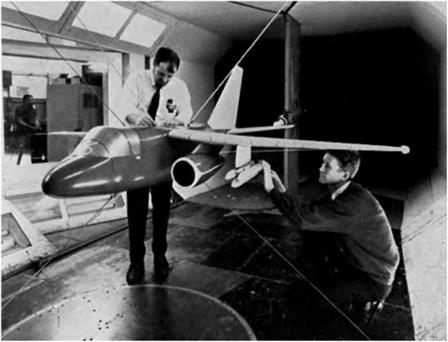Other experimental methods
Provided these three limitations are fully realised, and due allowances made for them, wind tunnel results can provide us with some very useful experimental data (Fig. 2G).
In addition to wind tunnel tests, experiments may be performed in the following ways
1. By experiments in water instead of air.
2. By experiments in actual flight.
Computational fluid dynamics (CFD)
Nowadays computers provide a powerful tool for the investigation of the flow around an aircraft or its components. The equations that describe the mechanics of the airflow (the Navier-Stokes equations) were known well
|
|
Fig 2G Model in wind tunnel
(By courtesy of the Lockheed Aircraft Corporation, USA) Model being prepared for flutter tests in wind tunnel
before the first flight. However, nobody could solve them, except for a few trivial cases. Even with the advent of computers, capable of performing millions of calculations per second, it is not possible to solve the exact equations but they can be solved approximately. With this powerful tool you might think that there is now no need for wind tunnels. However, there are problems. Data from wind tunnels have to be used in CFD to model turbulence and CFD is not very good at accurately predicting flows where there are large turbulent areas, such as at stall. Predicting flows is therefore still something of a black art. Tunnel results are prone to scale effects, which are difficult to interpret and CFD also has its problems (as does flight testing – it is hard, for example, to sort out effects due to the engine from those due to the airframe). Tike most things, there is no substitute for experience and ever more sophisticated ways are being developed to use the power of CFD and wind tunnel testing and flight testing to complement each other.
In the next chapter we look at how we use an aerofoil to produce the more desirable aerodynamic force, lift. Before reading this see if you can answer the following questions. If you can do so you have probably understood most of this chapter and you may proceed with confidence, but you should also try the numerical questions in Appendix 3.
Can you answer these?
11. What is the meaning of (a) subsonic, and (b) supersonic speeds?
12. What does the symbol ‘q’ stand for?
For solutions see Appendix 5.
For numerical questions on air and airflow see Appendix 3.












